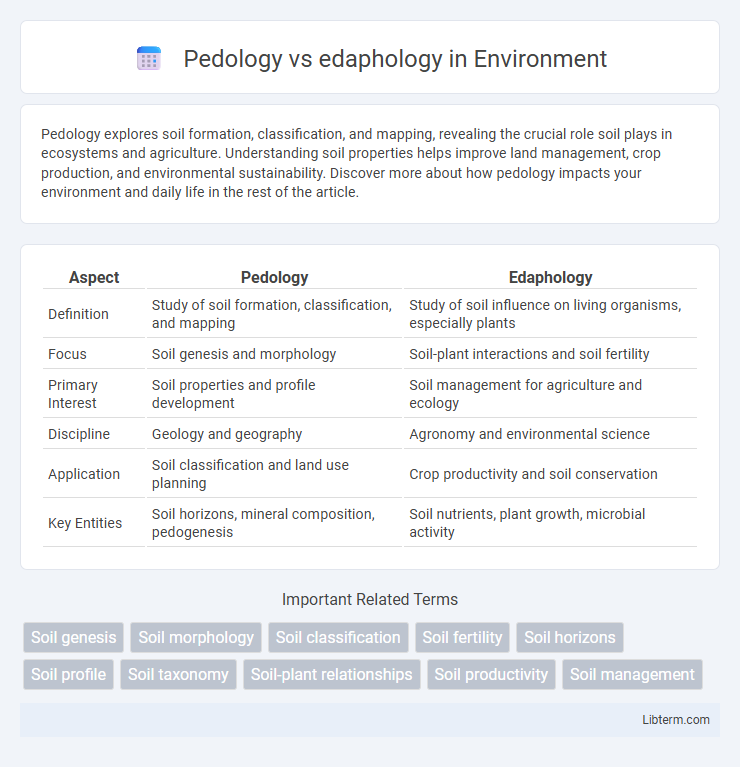Pedology explores soil formation, classification, and mapping, revealing the crucial role soil plays in ecosystems and agriculture. Understanding soil properties helps improve land management, crop production, and environmental sustainability. Discover more about how pedology impacts your environment and daily life in the rest of the article.
Table of Comparison
| Aspect | Pedology | Edaphology |
|---|---|---|
| Definition | Study of soil formation, classification, and mapping | Study of soil influence on living organisms, especially plants |
| Focus | Soil genesis and morphology | Soil-plant interactions and soil fertility |
| Primary Interest | Soil properties and profile development | Soil management for agriculture and ecology |
| Discipline | Geology and geography | Agronomy and environmental science |
| Application | Soil classification and land use planning | Crop productivity and soil conservation |
| Key Entities | Soil horizons, mineral composition, pedogenesis | Soil nutrients, plant growth, microbial activity |
Introduction to Pedology and Edaphology
Pedology is the scientific study of soil formation, classification, and mapping, focusing on soil as a natural resource within the Earth's pedosphere. Edaphology examines the influence of soil on living organisms, particularly plants, integrating soil's physical, chemical, and biological properties to assess its impact on agriculture and ecology. Both disciplines contribute to understanding soil functions but emphasize different aspects--pedology concentrates on soil genesis and morphology, whereas edaphology prioritizes soil's relationship with biotic factors.
Defining Pedology: The Study of Soil Formation
Pedology centers on the study of soil formation processes, examining soil morphology, genesis, and classification to understand how soil develops in natural environments. It involves analyzing the physical, chemical, and biological factors influencing soil horizons and profiles over time. Pedology differs from edaphology, which emphasizes soil's influence on living organisms, by focusing primarily on soil as a natural body within the Earth's pedosphere.
Understanding Edaphology: Soil’s Role in Plant Growth
Edaphology focuses on the influence of soil on plant growth, examining factors like soil composition, moisture, nutrients, and biological activity that directly affect vegetation development. This field studies soil-plant interactions to optimize agricultural productivity and ecological health, differentiating from pedology, which emphasizes soil formation, classification, and mapping. Understanding edaphology is essential for improving crop yields, managing soil fertility, and sustaining ecosystems by analyzing how soil properties support or hinder plant life.
Key Differences Between Pedology and Edaphology
Pedology focuses on the study of soil formation, classification, and mapping, emphasizing soil profile characteristics and genesis, while edaphology examines the influence of soil on living organisms, particularly plants and agriculture. Pedology is more concerned with the natural soil environment and its distribution, whereas edaphology applies soil science to improve plant growth, crop production, and ecosystem sustainability. Key differences lie in their objectives: pedology is a branch of soil science focused on soil as a natural body, and edaphology is an applied science targeting soil-plant relationships and agricultural productivity.
Historical Development of Soil Science Disciplines
Pedology and edaphology emerged as distinct branches of soil science during the late 19th and early 20th centuries, with pedology focusing on soil formation, classification, and mapping, while edaphology concentrated on the influence of soils on plant growth and agricultural productivity. Key figures such as Vasily Dokuchaev pioneered pedology by establishing soil as a natural body influenced by climate, organisms, relief, parent material, and time, laying the foundation for modern soil classification systems. Edaphology evolved through agronomic research aimed at understanding soil-plant interactions, nutrient cycling, and soil management practices critical for sustainable agriculture.
Core Concepts in Pedology
Pedology focuses on the study of soil formation, classification, and mapping, emphasizing soil properties, genesis, and morphology as core concepts. It examines soil horizons, texture, structure, and profile development within different landscapes to understand soil evolution and distribution. Edaphology, by contrast, primarily investigates soil influences on living organisms, particularly plant-soil interactions and fertility management.
Main Focus Areas of Edaphology
Edaphology primarily focuses on the influence of soil on living organisms, including soil biology, chemistry, and fertility, emphasizing its impact on plant growth and agricultural productivity. It investigates soil properties such as nutrient availability, microbial activity, soil moisture, and soil pH, playing a critical role in optimizing crop yields and sustainable land management. Pedology, by contrast, studies soil formation, classification, and morphology, concentrating on soil as a natural body within the environment.
Methods Used in Pedological Research
Pedological research employs methods such as soil mapping, classification, and morphological analysis to study soil formation, properties, and genesis. Techniques like field observation, laboratory testing of soil profiles, and remote sensing are crucial for understanding soil horizons and pedogenesis. These methods distinguish pedology from edaphology, which emphasizes soil's relationship with living organisms and employs more biological and ecological assessment tools.
Applications of Edaphological Studies in Agriculture
Edaphology, the study of soil influence on living organisms, plays a vital role in agriculture by informing soil management practices that enhance crop productivity and sustainability. Applications include optimizing soil fertility, improving irrigation techniques, and diagnosing soil constraints such as salinity or acidity that affect plant growth. Pedology focuses on soil formation and classification, providing foundational understanding while edaphology directly guides practical interventions for agricultural success.
Future Trends in Soil Science: Integration of Pedology and Edaphology
Future trends in soil science emphasize the integration of pedology and edaphology to enhance sustainable land management and agricultural productivity. Advanced technologies such as remote sensing, machine learning, and soil sensors enable detailed analysis of soil formation processes and soil-plant interactions. Collaborative research focusing on soil health monitoring and climate resilience fosters innovative solutions for ecosystem conservation and food security.
Pedology Infographic

 libterm.com
libterm.com